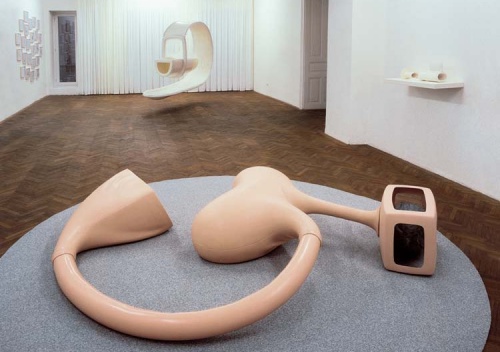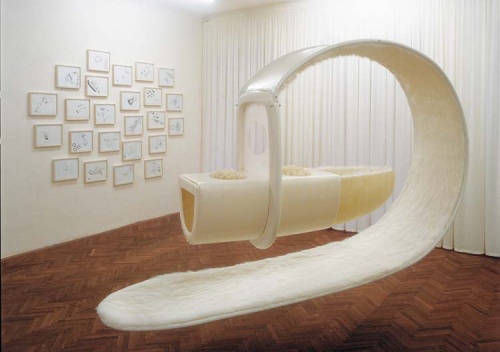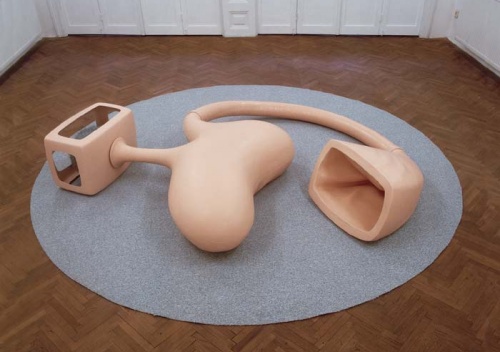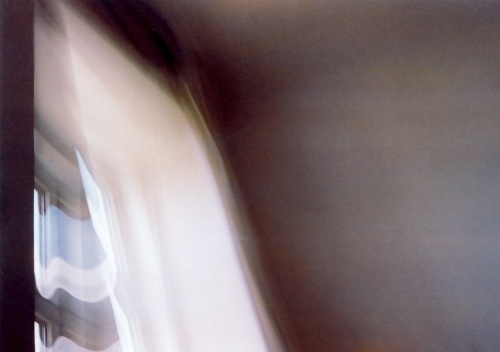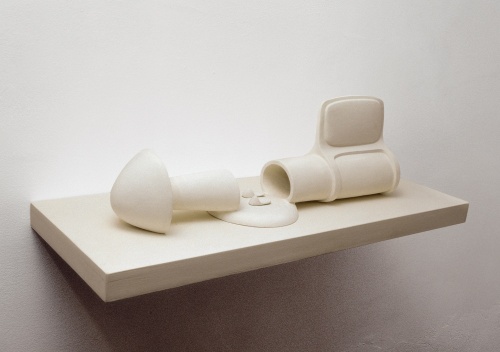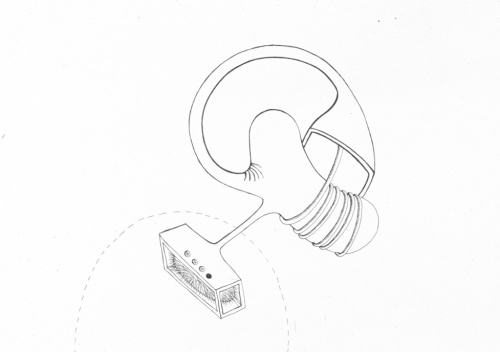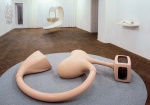 ... coming home (back), TV-Baby (front); Projektraum Victor Bucher, 2003
... coming home (back), TV-Baby (front); Projektraum Victor Bucher, 2003
Photo: Heinz Grosskopf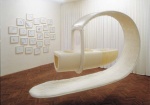 ... coming home, 2003; fibre glass, aluminium, vinyl, plush; 180 x 62 x 250 cm
... coming home, 2003; fibre glass, aluminium, vinyl, plush; 180 x 62 x 250 cm
Photo: Heinz Grosskopf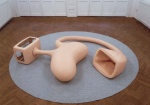 TV-Baby, 2002; silicone, foam rubber, fibre glass, plush, carpet; 50 x Ø carpet: 300 cm
TV-Baby, 2002; silicone, foam rubber, fibre glass, plush, carpet; 50 x Ø carpet: 300 cm
Photo: Heinz Grosskopf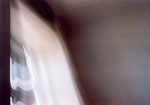 O.T., 2003; photo on aluminium; 80 x 110 cm
O.T., 2003; photo on aluminium; 80 x 110 cm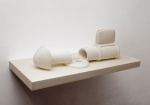 Patschenkino, 2002; clay, acryllic paint; 60 x 18 x 15 cm
Patschenkino, 2002; clay, acryllic paint; 60 x 18 x 15 cm
Photo: Heinz Grosskopf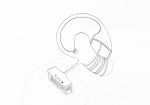 O.T., 2002, ink pen on paper; 21x30 cm
O.T., 2002, ink pen on paper; 21x30 cm
Coming home
, Projektraum Viktor Bucher, Vienna 2003
Coming Home or: Arriving on Foreign Shores
Andreas Höll
The German philosopher Ernst Bloch once described the highly allusive word "Heimat" (= home, homeland) as „something which shines into the childhood of all and in which no one has yet been". This famous key statement taken from his main work "The Principle of Hope" (Das Prinzip Hoffnung) sketches the utopia of a fulfilled life – a person is able to find fulfilment in work and to overcome his own sense of alienation in the capitalist world. His promise for happiness: the process of history ultimately brings us – all of us who have been driven out of paradise – back home.
Being home in the world – or better: searching for home – also implies something unhomely or uncanny. In the familiar environment of home there always looms the unknown outside world, something alien. Something taken to be natural always also implies something unnatural. The sense of cosiness can literally be threatened by something unhomely, just as the soul and the animate are by the inanimate. This is the critical point from where Julie Hayward’s works take off. They play with the intricate tension between coming home and a sense of being forlorn, coming into one’s own and self-alienation, encounter with the familiar and something alienating.
First there is "… coming home". The object is reminiscent of a futuristic cradle promising security. But it could also be alluding to a biotech lab. In two bowls there are piles of balls resembling beads. Huge heaps of cells or artificially produced biomass? Both receptacles are separated by a sheet of glass with a hole that is shaped the same way as the bowls. This arrangement suggests a mechanized process. The guillotine-like apparatus could trigger off a sequence of movements. Possibly it is something like a sterile insemination where piles of cells are supposed to merge in a mysterious way. The bizarre device with its scifi look seems to be bringing forth artificial life. But at the same time it might be offering a protective realm where what has been created can thrive and grow.
The two separate bowls of beads could also allow a different interpretation. They could be balls that were carefully collected with this device, and stored perhaps for further processing. Instead of insemination the idea then would be to preserve something, to arrange or put together something. The sterile lab character of the sculpture is reinforced by white paint while the white plush lends it something organic.
A typical feature of Julie Hayward’s sculptures is this both appealing and irritating connection of technoid and organic forms. "TV-Baby" is also one of the hermaphrodites that evoke the mechanisms of a future biotechnology. It remains enigmatic how the plastic cyber-organism is to function. At the same time the piece is an allusive and ironic symbol for the dissolution of reality in the media. It is no longer clear who sends and who receives a message and what the message is. This diffuse power of the media emanates and infects the strangely amorphous mass of something that cannot be defined and is bare and defenceless. It is a repressive idyll that is revealed in the flickering light of the imagined moving images. The maelstrom of imagery seems to suck in one’s personal life, one’s own consciousness and to lead us to the total regression of mollusc-like existence. The world of appearances which feigns a reflection of reality only produces illusionary life in the pale reflection of television.
(...)
It is in this spirit that Julie Hayward designs her sculptural installations. They reflect something futuristic and the memory of past utopia, the flair of the surreal and of the rational calculus. These are strange parallel worlds that evoke ambivalent feelings and unconscious fears. They alienate the allegedly familiar and thus also lead us to the uncomfortable insight: Home is where I hang my hat.
cited from
Coming Home or: Arriving on Foreign Shores
Andreas Höll
read entire text
